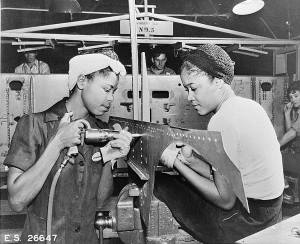Although during this time most of the country’s women “working roles” had to include marriage and becoming a mother, paid work was possible for all but a few groups of women (1). In addition to the challenges white females faced, minority groups at the time were dealing with a unique range of impediments to their socioeconomic mobility (3). Consistent with the disparities wrought in the New Deal and G.I. Bill policies, black American and “foreign-born” women didn’t have the choice to work, but instead they had to in order to survive (2). The dominance of America’s white power structure framed WWII as “a white war” in which minorities had no important place (2).
As white women were seemingly welcomed with open arms into the labor force, Latino and African American women were often turned away from decent jobs or earned much less than their white counterparts (3). African American women were also limited to lower positions with fewer responsibilities and less pay (3).
This was further exacerbated after war, which many African American women were fired before their white counterparts (3).
Mary Newson describes her experience of leaving school and entering into her first job to help the war effort. She explains the struggles of attempting to keep this job after the war was over, with employers pressuring women to quit.
At the end, Phyllis Gould begins to explain the social dynamic of marriage during the war.
However, studies suggest minority women entering the workforce had some positive impact on the Civil Rights Movement in the 1950s and 1960s (4). This is partially due to increased interaction of whites with other races, but also because certain worker groups pushed for policies (4). One of the most striking examples is the women’s struggle in the automobile manufacturing industry was a driving force to support the Equal Rights Amendment by the United Auto Workers (UAW) (4).
References:
(1) Margaret Mead, “Cultural Aspects of Women’s Vocational Problems in Post World War II,” in Journal of Consulting Psychology, 10 (1946): 23-28.
(2) Murray, Florence. “The Negro and Civil Liberties during World War II.” Social Forces, (Dec., 1945) Vol. 24 (2): 221-216.
(3) Gordy, Laurie L; Hogan, Jennifer; Pritchard, Alice. “Assessing “Herstory” of WWII: Content Analysis of High School History Textbooks.” Excellence in Education, (2004) Vol. 37: 80-91.
(4) Gabin, N. (1985). Women and the United Automobile Workers union in the 1950s. In R. Milkman (Ed.), Women,
work and protest: A century of U.S. women’s labor history
(pp. 259–279). New York: Routledge & Kegan Paul.


